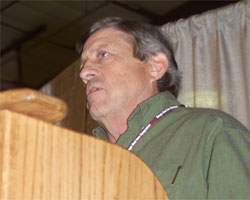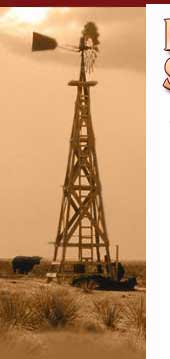|
Selecting for carcass marbling and muscle – benefits and pitfalls
Jim Gosey, Beef Specialist, UNL

In this day of age of technology we have the tools available to make mistakes faster and with greater accuracy than at any time in history, said Extension beef specialist Jim Gosey. He advised producers to practice balanced, multiple-trait selection and avoid single-trait selection for either marbling or muscling. |
Large premiums for Choice (Ch) vs. Select (Se) carcasses and substantial discounts for Yield Grade (YG) 4 carcasses provide incentive for beef cattle producers to select for carcass traits. University of Nebraska Extension beef specialist Jim Gosey, (NU) advised producers at the 2003 Range Beef Cow Symposium to practice balanced, multiple-trait selection for carcass merit and to avoid single-trait selection for either marbling or muscling.
"The difficulty lies in achieving the optimum balance of traits, especially considering the powerful impact of reproduction and production traits on ranch profitability," Gosey said. Ranchers should match their cattle to ranch resources first and adjust carcass traits only as much as those resources reasonably allow."
Gosey warned producers to be aware of genetic antagonisms between traits. Some genes have multiple effects, and change does not occur in a vacuum. Inevitably, other traits are affected. A negative correlation between marbling and leanness illustrates why improvement through selection can be difficult and slow to achieve. Simultaneous change in both traits can be achieved — if selection pressure is applied to both traits.
There is limited research estimating the genetic correlation between carcass traits and reproductive traits. However, studies do suggest that when applying selection pressure for muscling producers should be wary to avoid an associated higher age at puberty, lower conception rate, greater calving difficulty and larger mature weight.
"Selection to jointly improve antagonistic carcass traits, like marbling and muscling, within a single breed is difficult," Gosey said. "However, there are ‘outlier’ or ‘curve bender’ bulls that defy some of the antagonisms between traits, but they are rare."
Gosey suggested complementarity through crossbreeding, or the matching of strengths of one breed to weaknesses of another breed, as a way to conquer antagonisms between carcass traits. This concept is demonstrated by the improvement in net merit achieved by matching the marbling input of a British breed with the lean muscle growth of a Continental breed.
Developments in DNA marker technology to test for marbling and tenderness genes provide additional tools for including carcass traits in selection programs. Gosey warns that DNA tests explain only a portion of the variation for these traits, but they offer seedstock breeders an option for screening young bulls for further progeny testing. Primarily due to costs currently associated with DNA testing, Gosey doesn’t view the technology as a realistic option for commercial operators.
— by Troy Smith
Click here to download the presentation (in pdf format).
 You will need Acrobat Reader to view. You will need Acrobat Reader to view.
Click the image to download a free copy.
Click here to listen to the presentation
You will need Windows Media Player to listen in.
Click here to download a free version.
|
